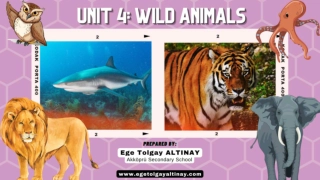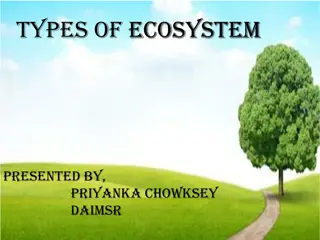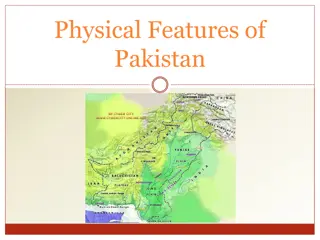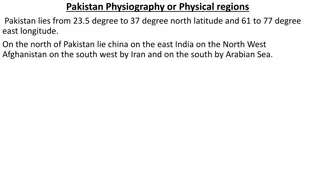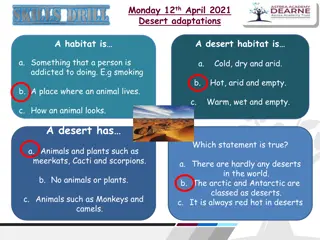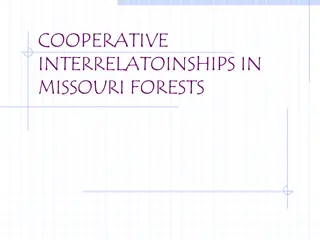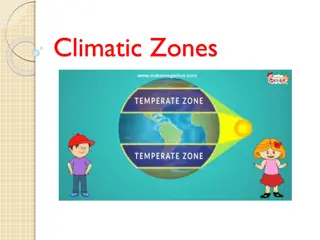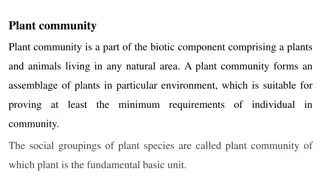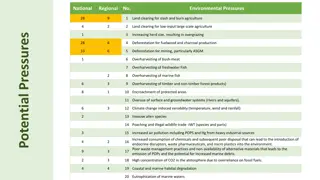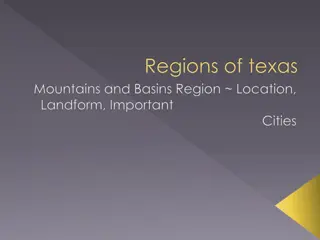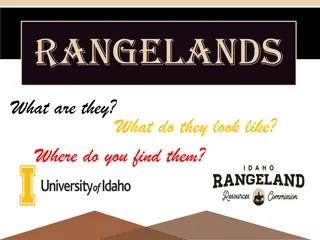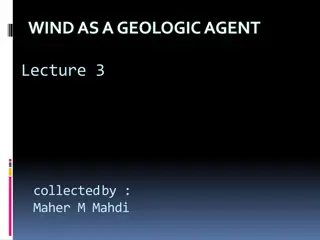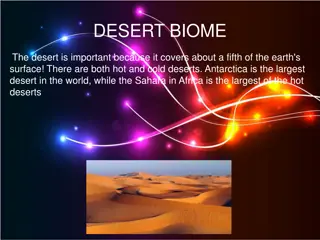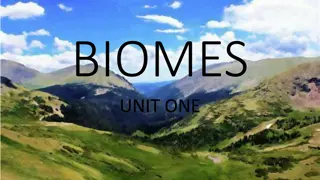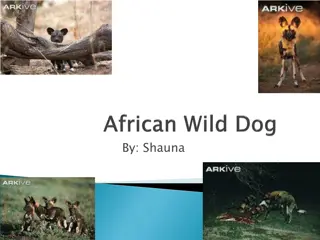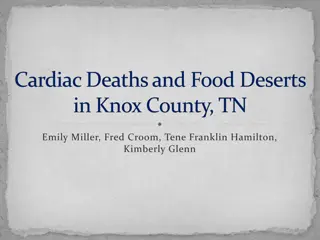Understanding Ecosystems: Types, Components, and Interactions
Different types of ecosystems, their components, and how they interact with each other. Explore natural ecosystems, such as deserts and rainforests, as well as artificial ecosystems. Discover the importance of terrestrial, aquatic, forest, marine, freshwater, tundra, and grassland ecosystems.
4 views • 6 slides
Explore the Fascinating World of Wild Animals and Their Habitats!
Journey through a visual encyclopedia showcasing a variety of wild animals such as bears, cheetahs, elephants, and more, along with information on different animal types like mammals, reptiles, and birds. Discover the diverse habitats where these creatures reside, from jungles and forests to deserts
0 views • 35 slides
Exploring Different Ecosystem Types and Functions
Learn about the major types of ecosystems such as Grassland, Aquatic, Forest, and Desert presented by Priyanka Chowksey of DAIMSR. Understand the components of an ecosystem, including biotic and abiotic factors, and the significance of different ecosystems like Forest Ecosystem and Desert Ecosystem.
4 views • 29 slides
Discovering Oman: A Comparison of Landscapes
Explore the unique physical features of Oman, from its rocky deserts to towering mountains and scenic coastlines. Contrasting with the UK, discover how Oman's natural landscapes offer a fascinating glimpse into its geological diversity.
7 views • 11 slides
Physical Geography of Pakistan: Mountains, Plains, Plateaus, and Deserts
Pakistan's diverse physical features include towering mountains like the Karakoram and Himalayas, expansive plains, elevated plateaus, and vast deserts. The country shares borders with China, India, Iran, Afghanistan, and the Arabian Sea. The Northern Mountains consist of distinct ranges like the Ka
1 views • 29 slides
Physiography and Physical Regions of Pakistan
Pakistan's physiography spans diverse physical regions, including mountains, plains, plateaus, and deserts. The country is bordered by China, India, Afghanistan, Iran, and the Arabian Sea. Key mountain ranges include the Himalayas, Karakoram Mountains, and the Hindu Kush. Pakistan's total area is 79
1 views • 13 slides
Desert Adaptations: Animals and Habitat Survival
Habitats play a crucial role in the survival of animals, especially in harsh environments like deserts. Explore the unique adaptations of animals like camels and learn how they are perfectly suited to thrive in hot, arid conditions. Understanding these adaptations is key to appreciating the diversit
0 views • 16 slides
Understanding Biomes: Climate, Vegetation, and Adaptations
Biomes are vast regions defined by climate, plant and animal communities. Factors like climate, geography, and vegetation impact the unique characteristics of each biome. Understanding biomes involves knowledge of climate, geography, vegetation adaptations, and animal diversity. Changes in one part
0 views • 23 slides
Exploring Symbiotic Relationships in Missouri Forest Ecosystems
Delve into the intricate web of cooperative interrelationships within Missouri forests, where diverse communities coexist in a delicate balance. Discover the concept of ecosystems, from deserts to lakes, and learn about symbiosis through examples of parasitism and commensalism. Explore the fascinati
0 views • 18 slides
Exploring Earth's Climatic Zones
The Earth is divided into three climatic zones - Tropical Zone, Temperate Zone, and Polar Zone. The Tropical Zone is home to many countries and features diverse climates, including deserts. Nomads in this zone lead a mobile lifestyle, living in tents or huts and wearing protective clothing. Moving t
0 views • 36 slides
Understanding Plant Communities and Their Characteristics
Plant communities are essential components of natural ecosystems, comprising plants and animals that thrive in specific environments. They exhibit species diversity, various growth forms, self-sufficiency, dominance of certain species, and succession patterns. Communities can be classified based on
1 views • 14 slides
Environmental Pressures and Biomes Overview
The content provides an overview of various environmental pressures such as land clearing, deforestation, overharvesting, climate change, and more. It also outlines different biomes including temperate forests, tropical grasslands, deserts, and marine ecosystems. The document aims to highlight the c
1 views • 13 slides
Exploring India: A Journey Through Geography and Pride
India, a vast and diverse country, is explored in this presentation starting from its physical features such as mountains, plains, plateaus, and deserts. The rich heritage of India is showcased through images and descriptions, highlighting the country's unique characteristics and geographical divers
0 views • 23 slides
Understanding Xerosere: Plant Succession in Dry Environments
Xerosere is a plant succession process limited by water availability, starting from bare rocks and advancing through stages of lichen colonization to moss growth. This ecological progression, initiated in dry environments like deserts and rock formations, demonstrates how plant communities establish
0 views • 18 slides
Child Care Challenges in Kentucky: The Child Care Cliff
Explore the landscape of child care in Kentucky, revealing the challenges families face with the Child Care Cliff. Discover statistics on child care centers, family child care homes, and the average cost of child care in Kentucky. Understand the importance of the Child Care Assistance Program (CCAP)
0 views • 18 slides
Exploring Different Types of Ecosystems and Their Characteristics
Ecosystems are diverse environments encompassing both living organisms and non-living factors. From forest and grassland ecosystems to deserts and tundras, each type has unique features and interactions. Forests house a variety of organisms, while grasslands are dominated by grass and herbs. Deserts
0 views • 10 slides
Understanding Ecosystems and Global Biomes: A Comprehensive Study
Explore the fascinating world of ecosystems, producers, consumers, and the vital role of decomposers within these intricate systems. Delve into the impact of environmental changes like deforestation on ecosystems. Discover the geographical features and significance of hot deserts, tropical forests,
0 views • 26 slides
Explore the Mountains and Basins Region of Texas
Discover the unique Mountains and Basins Region of Texas, located in the far west with the Rio Grande as its southern border and New Mexico to the north. This region features diverse landforms including mountains, plateaus, basins, deserts, and rivers like the Pecos and Rio Grande. Important cities
0 views • 19 slides
Understanding Biomes: Concept, Classification, and Factors
Biomes are large natural ecosystems encompassing plant and animal communities shaped by shared physical climates. They are classified based on climate, vegetation, soil-water, and heat availability, encompassing diverse environments like deserts, forests, savannas, and oceans. The concept of biomes
0 views • 6 slides
Exploring Various Ecosystems Through Food Webs
Delve into the intricate relationships between organisms in different ecosystems through visually captivating food web illustrations. From the Antarctic to boreal forests, grasslands, deserts, and marine environments, witness the complex interactions between producers, herbivores, carnivores, and mo
0 views • 15 slides
Understanding Rangelands: An Overview of Natural Landscapes
Rangelands are uncultivated lands dominated by native plants such as grasses, forbs, and shrubs. They encompass areas not used for farming, dense forests, barren deserts, or solid rock. Rangelands support diverse ecosystems and are essential for various wildlife habitats and grazing animals.
0 views • 13 slides
Wind as a Geologic Agent in Shaping Landscapes
Wind has played a significant role in shaping landscapes during times of drier climates, being a key geologic agent impacting erosion and deposition processes. The global wind system, driven by factors such as heating from the sun and the rotation of the Earth, creates convection currents that circu
0 views • 31 slides
Discovering the Fascinating Desert Biome
The desert biome covers a significant portion of the Earth's surface, with hot and cold deserts existing worldwide. Learn about the unique weather patterns, diverse flora and fauna, and the remarkable adaptations of plants and animals that make deserts their home. Explore the beauty and importance o
0 views • 5 slides
Global Warming Solution: HelioHydroElectric Technology by Martin E. Nix
HelioHydroElectric technology utilizes salt/seawater and solar energy to generate electrical power through innovative methods such as flooding basins below sea level in deserts, pumping seawater inland with solar and wind power, and creating evaporation ponds. This sustainable approach not only prod
0 views • 56 slides
Understanding Biomes and Ecosystems in Nature
Exploring the concept of biomes and ecosystems, the interaction between living and nonliving elements in nature, the adaptation of species to their habitats, and the different types of biomes like tundra, forests, grasslands, deserts, and aquatic biomes. The extreme conditions of tundra and deserts
0 views • 18 slides
Developing the Illinois Early Childhood Participation Data Set
The Illinois Early Childhood Asset Map project aims to develop the Illinois Early Childhood Participation Data Set (ECPDS) in collaboration with various organizations and agencies, including the University of Illinois, Chapin Hall, Northern Illinois University, ISBE, IDHS, and ILDS. This initiative
0 views • 7 slides
Weekly Chinese Learning Objectives and Projects
Explore new words, practice grammar concepts, and engage in animal projects in this week's Chinese class. Review, practice, and create descriptions of animals while learning vocabulary related to different habitats like grasslands, mountains, rivers, oceans, and deserts. Participate in quizzes, desc
0 views • 13 slides
The Noble Camel: General Information, Physical Characteristics, Habitats, Behaviors, and Interesting Facts
The Camelus Dromedarius, known as the camel, has distinctive characteristics such as its hump(s) for storing fat and surviving in deserts and semi-arid grasslands. Camels can endure extreme heat, lack of water, and can go months without drinking due to their unique adaptations. They are herbivores,
0 views • 6 slides
Understanding Global Ecosystems and Tropical Rainforests
Ecosystems exist at various scales, influenced by both living and non-living components. Global atmospheric circulation shapes the distribution of biomes like tropical rainforests and hot deserts. Tropical rainforests, with distinct environmental characteristics, face threats like deforestation. Sus
0 views • 15 slides
Discovering Earth's Biomes and Climate Through Jeopardy Questions
Explore Earth's diverse biomes and climate concepts by playing a virtual Jeopardy game. Test your knowledge on topics such as deserts, biomes, climate, atmospheric layers, and elemental compositions of air. Learn interesting facts about penguins, living organisms in the ground, winds, and more.
0 views • 27 slides
Understanding Deserts and Desertification: Factors and Consequences
Delve into the intricate mechanisms behind the formation of deserts and desertification. Explore how low and high-pressure zones, monsoons, and global air pressure contribute to the creation of arid landscapes. Discover the impact of air currents, humidity, and the Equator on the development of dese
0 views • 15 slides
Fascinating Facts About African Wild Dogs
African wild dogs, also known as painted wolves, are versatile animals found in mountain forests and deserts in Africa. They have a unique appearance with colors of black, gray, yellow, and white, and exhibit interesting behaviors like competing with hyenas and lions for food. These social animals l
0 views • 10 slides
Understanding Food Choices and Food Justice
Explore the factors influencing food choices, nutrition labels, access to healthy food, and the concept of food justice. Learn about food deserts, different diets, and why we choose the foods we eat. Discover solutions for living in food deserts and making informed dietary decisions within a 40-minu
0 views • 12 slides
Overview of Sparsely Populated Regions on Earth
Sparsely populated regions, such as deserts, dry lands, wet lands, and cold lands, are areas with harsh conditions that are not suitable for extensive human settlement. The ecumene, the portion of the Earth's surface where permanent human settlement is possible, has expanded over time, but only a sm
0 views • 12 slides
Understanding Deserts and Desertification: Lecture Insights by Maher M. Mahdi
Delve into the world of deserts and desertification with valuable insights collected by Maher M. Mahdi. Explore definitions of deserts, steppe regions, and semi-arid climates. Learn about the dryness ratio, distinguishing factors between true deserts and semi-deserts, and Budyko-Lettau dryness ratio
0 views • 22 slides
Life in Deserts: Harsh Yet Vibrant Ecosystems
Deserts, the driest and hottest places on Earth, host a surprising variety of animals that have adapted to scarce water sources and scorching heat. From gerbils seeking shade in underground burrows to beetles collecting water droplets, these creatures demonstrate remarkable survival strategies. Desp
0 views • 4 slides
The Amazing Desert Tortoise: Surviving Adversity in the Sonoran/Mohave Deserts
The desert tortoise, a fascinating creature of the Sonoran/Mohave Deserts, adapts to its harsh environment by hibernating, foraging on cacti and grasses, and obtaining water from its food. This resilient herbivore has a low reproductive rate and faces many predators but can live up to 50 years. Expl
0 views • 11 slides
Integrated Plan to Combat Food Deserts in Virginia
Virginia Executive Institute's Fall 2017 Cohort has developed an integrated plan to address the issue of food deserts in Virginia. Defined as areas with limited access to affordable and nutritious food, these deserts contribute to the obesity epidemic and various health concerns. Research findings h
0 views • 16 slides
Study on Cardiac Deaths and Food Deserts in Knox County, TN
This project aims to investigate the correlation between cardiac deaths and access to healthy foods in Knox County, TN. Utilizing Death Statistical Systems data and Census Tract Data from the 2010 census, the study examines age-adjusted rates to compare populations. The research is conducted in coll
0 views • 25 slides
Impact of Geography on Fertile Crescent Civilizations
The geography of the Fertile Crescent, characterized by deserts, rivers, plains, and mountains, shaped the development of ancient civilizations. Deserts offered protection, river floods provided fertile soil for farming, and rivers served as crucial water sources for food, trade, and transportation.
0 views • 19 slides

